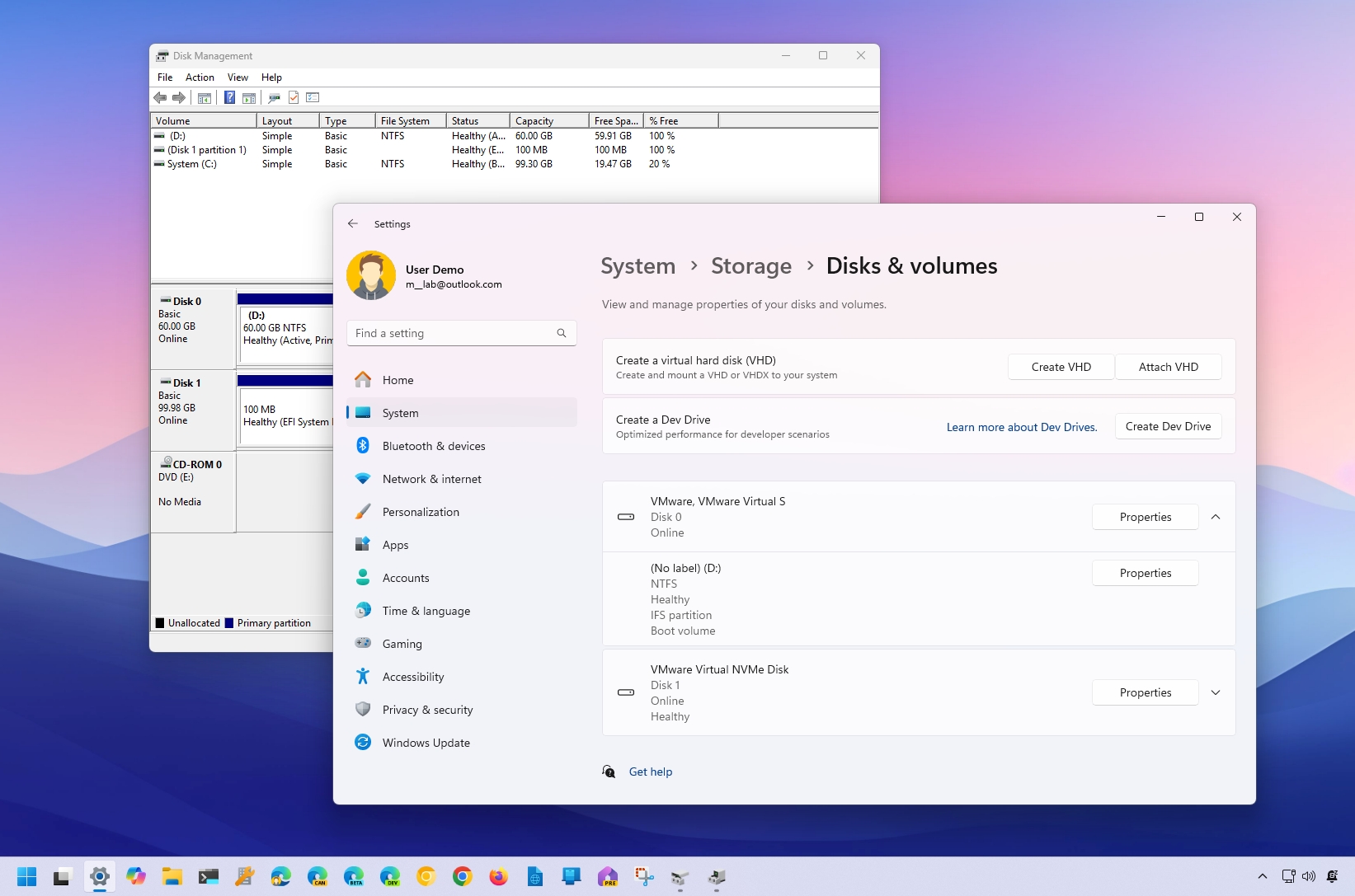
On Windows 11, the system can automatically recognize and set up most storage drives, including hard disk drives (HDD), solid-state drives (SSD), and external USB hard drives (as well as flash drives). However, if the hard drive doesn't show on File Explorer, you will have to perform different troubleshooting steps to resolve the issue.
For instance, if File Explorer fails to list one of the hard drives, it could be a physical connection problem or missing configuration. You could be trying to set up a drive from another device, and depending on the configuration, it may not appear on your computer. The partition could have gotten corrupted, or it was never configured in the first place.
Whatever the issue might be, Windows 11 provides the tools to troubleshoot virtually any problem to make the drive accessible through the Settings app, Disk Management, Device Manager, and Command Prompt.
In this how-to guide, I will walk you through the steps to troubleshoot and fix (most) problems causing File Explorer not to show a specific hard drive on Windows 11.
How to fix missing storage on File Explorer via physical troubleshooting
The system may not be able to show a particular drive on File Explorer for many reasons, and before you start changing settings, it's recommended to check the physical connection with the storage:
- Check the storage is correctly connected to the device and receiving power.
- If this is an external USB hard drive, disconnect it and try a different USB port. For example, if the drive is connected using a port in the back, try the USB ports in the front of the computer case. If you use a USB hub, connect the drive directly to the machine, as the issue could be the hub not supplying the correct amount of power or another problem.
- If it is an internal hard drive, ensure the data and power cables (if applicable) are securely connected to the drive, motherboard, and power supply. Before getting your hands inside the case, power off and unplug the computer.
- Connect the hard drive to another machine to check whether the problem is the hard drive or the computer.
- Access the computer's Unified Extensible Firmware Interface (UEFI) and ensure the firmware detects the storage. The motherboard firmware can be different per manufacturer and even per device model. As such, check the manufacturer support website for more specific instructions.
After checking for physical problems, you can proceed to fix the most common problem preventing File Explorer from showing a hard drive on Windows 11.
How to fix missing storage on File Explorer via Device Manager
It doesn't happen often, but the hard drive could be disabled, which can be quickly resolved using Device Manager.
To enable a storage drive from Device Manager, use these steps:
- Open Start.
- Search for Device Manager and click the top result to open the app.
- Expand the Disk drives branch.
- Right-click the hard drive in question and select the Properties option.
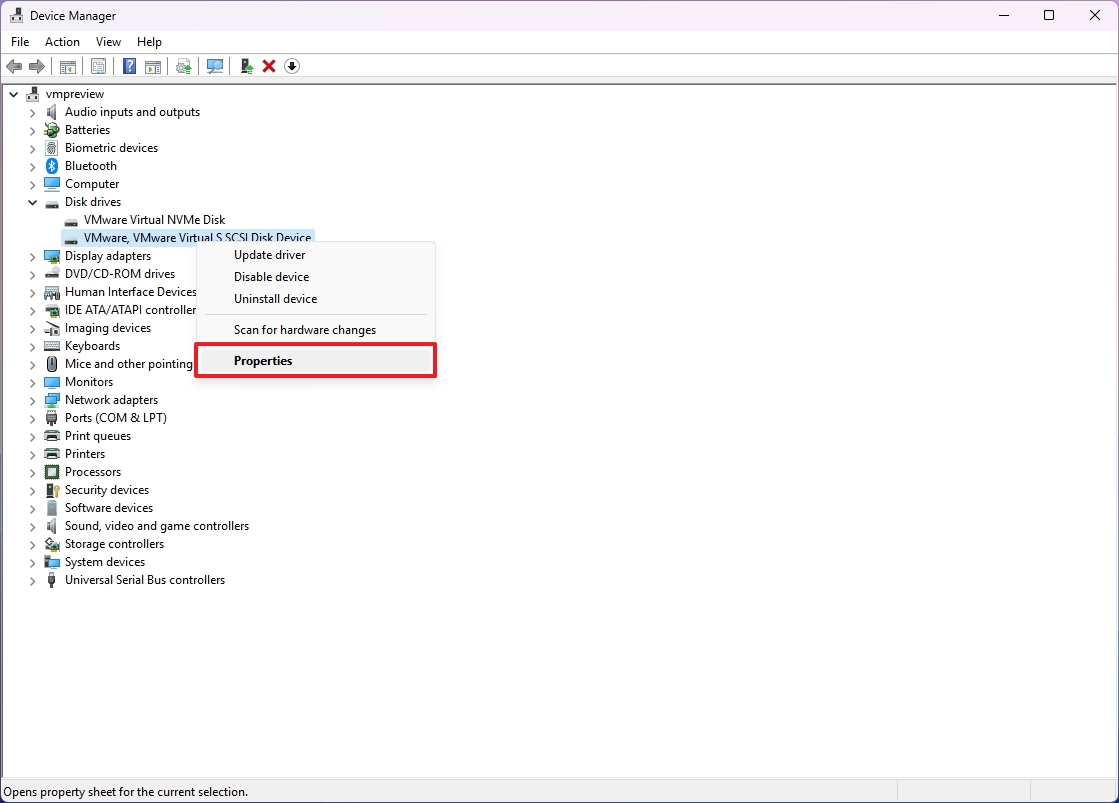
- Click the Driver tab.
- Click the Enable Device button.
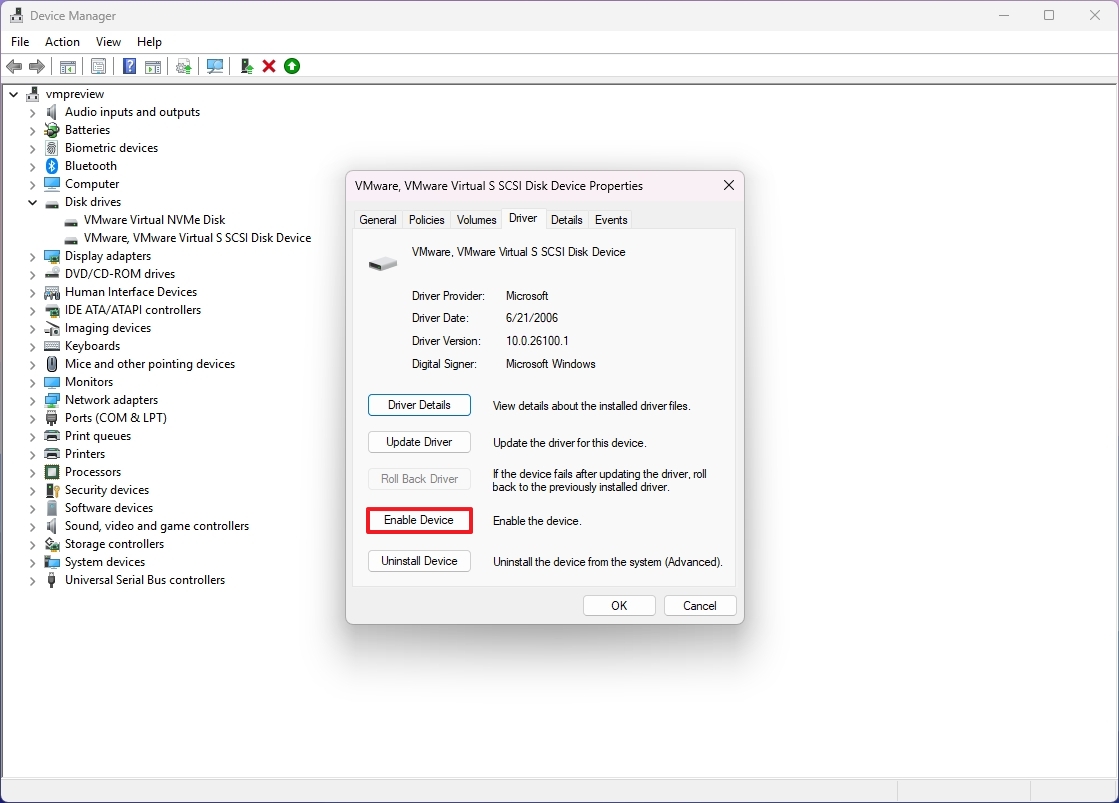
- Click the OK button.
After completing the steps, the drive should appear on File Explorer.
How to fix missing storage on File Explorer via Disk Management
On virtually any version of Windows, some requirements need to be met for a drive to appear on File Explorer. First, the storage must be online and initialized. Also, it has to have a partition and a drive letter assigned, or it should be mounted as a folder.
If you have to configure the hard drive, you can do this from the Disk Management app.
Change drive to online
To bring the drive online on Windows 11, use these steps:
- Open Start.
- Search for Disk Management and click the top result to open the app.
- Right-click the disk with the "Offline label" and select the Online option.
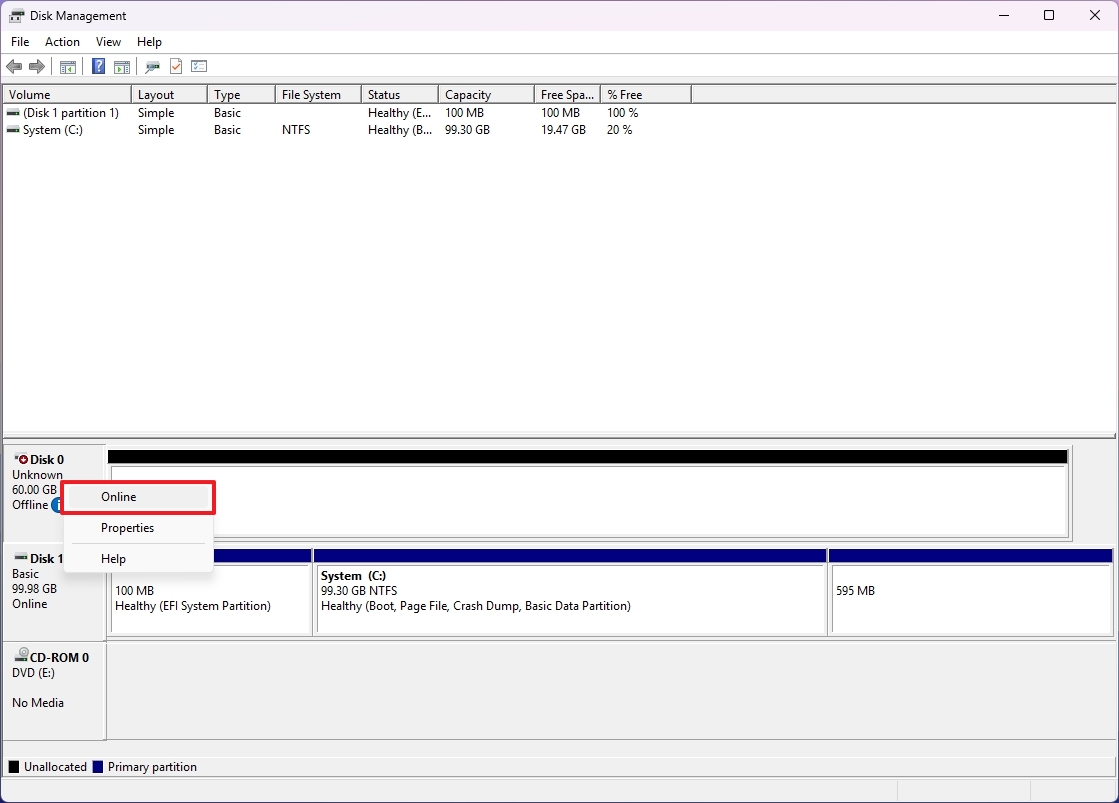
Once you complete the steps, the drive and data should now be accessible from File Explorer.
In the case that the storage was offline and never configured, continue with the steps below to initialize it.
Initialize new drive
To initialize a hard drive on Windows 11, use these steps:
- Open Start.
- Search for Disk Management and click the top result to open the app.
- Right-click the disk with the "Unknown" label and select the Initialize Disk option.
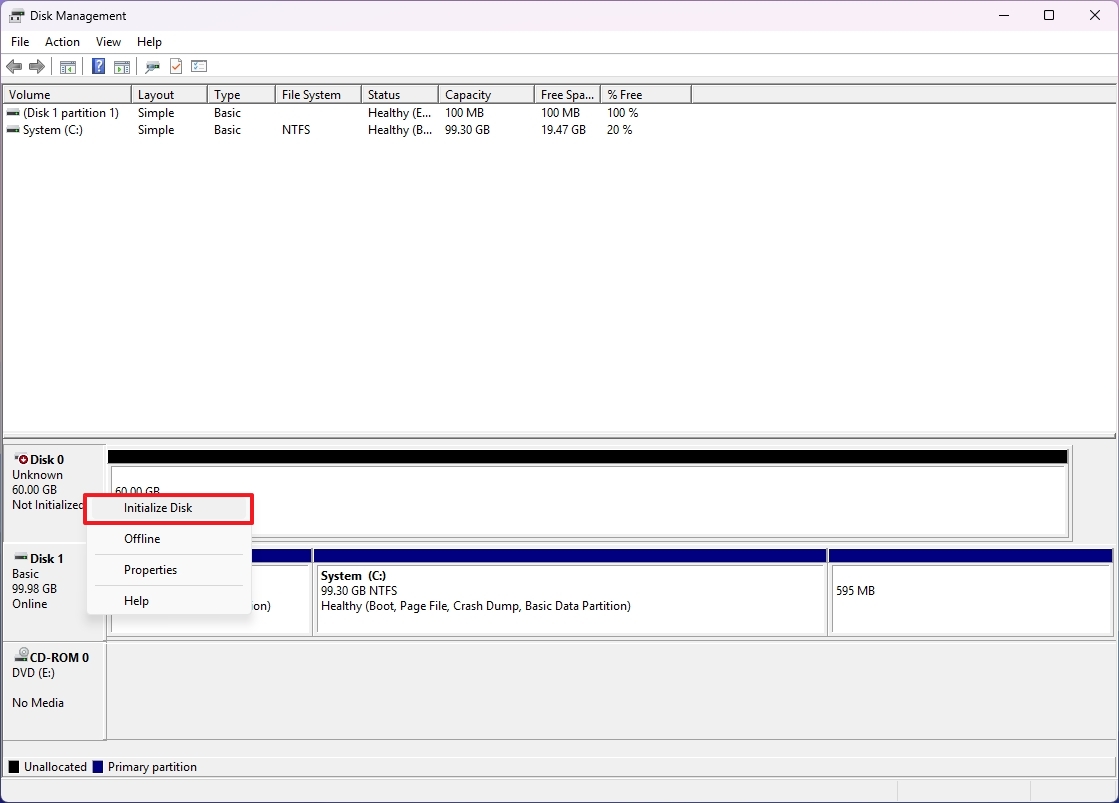
- Check the drive to initialize under the "Select disks" section.
- Select the "GPT (GUID Partition Table)" option.
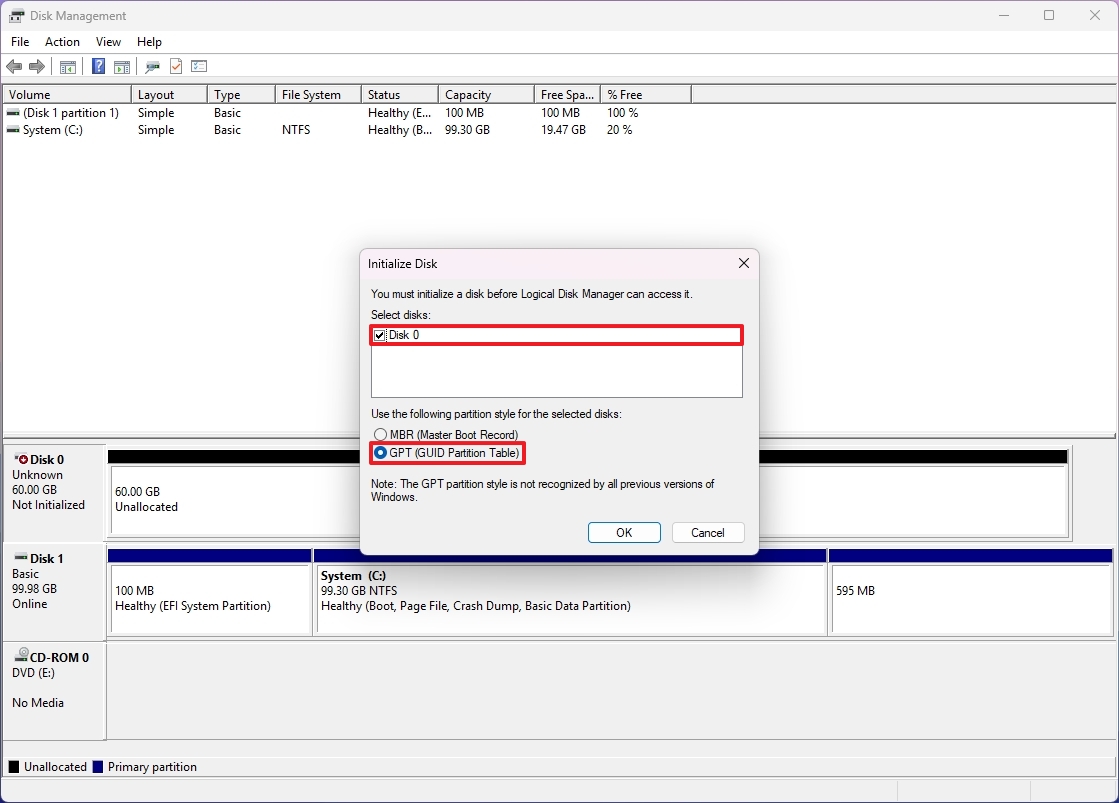
- Click the OK button.
After completing the steps, this process will wipe out the drive's contents and prepare it to be formatted if the drive was never initialized.
Configure drive letter
When the hard drive is online and initialized and does not appear in the system, it could be for two reasons: the storage device does not include a drive letter, or if it was configured to another computer, the system may be trying to assign the same drive letter already assigned to another device.
To assign a drive letter on Windows 11, use these steps:
- Open Start.
- Search for Disk Management and click the top result to open the app.
- Right-click the partition on the hard drive without a drive letter and select the "Change Drive Letter and Paths" option.
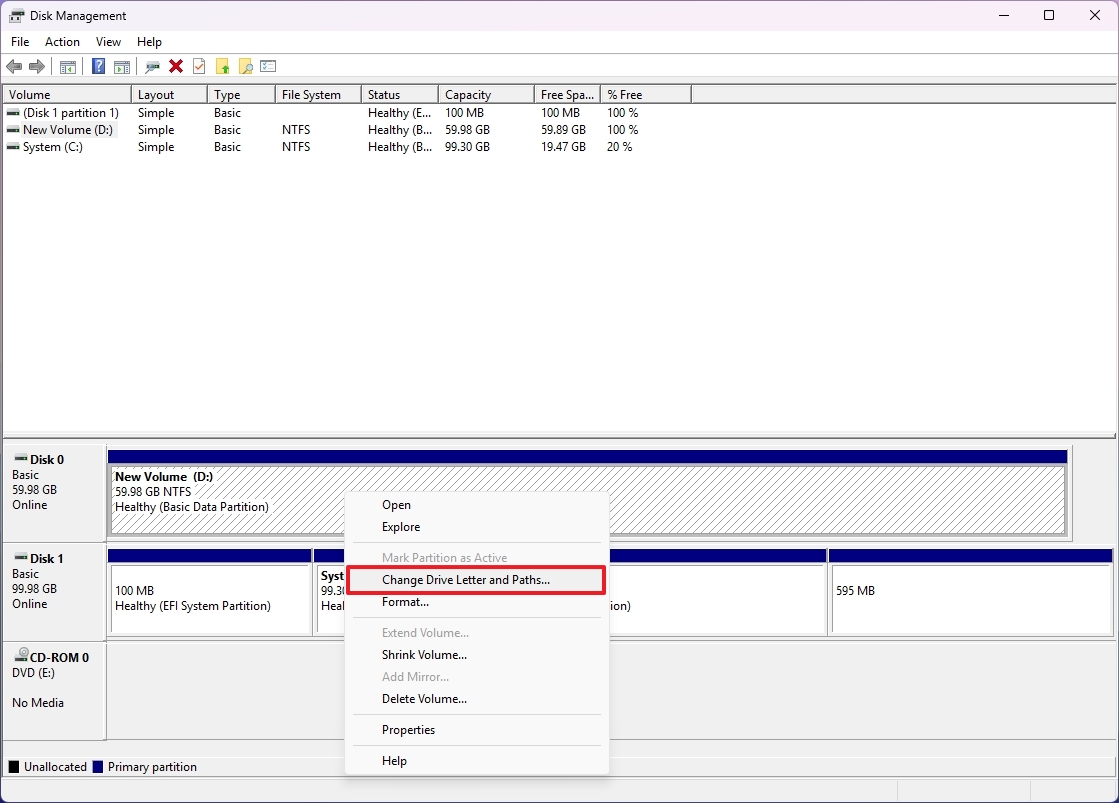
- Click the Add button.
- Select the "Assign the following driver letter" option.
- Choose the drive letter.
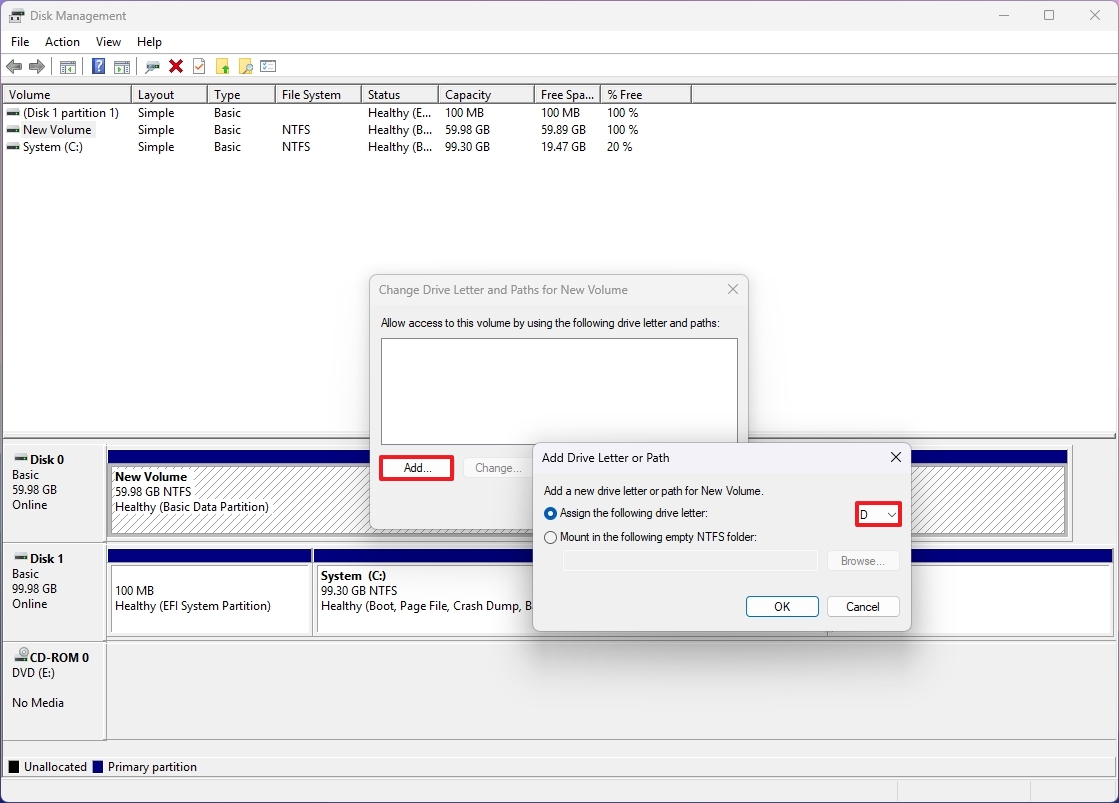
- Click the OK button.
After you complete the steps, the data should now be accessible on Windows 11.
Configure new partition
If the drive is online and initialized, it may not have a partition. You can resolve this issue by creating and formatting a partition and assigning a letter.
To configure a hard drive to appear on File Explorer, use these steps:
- Open Start.
- Search for Disk Management and click the top result to open the app.
- Right-click the partition on the drive and select the "New Simple Volume" option.
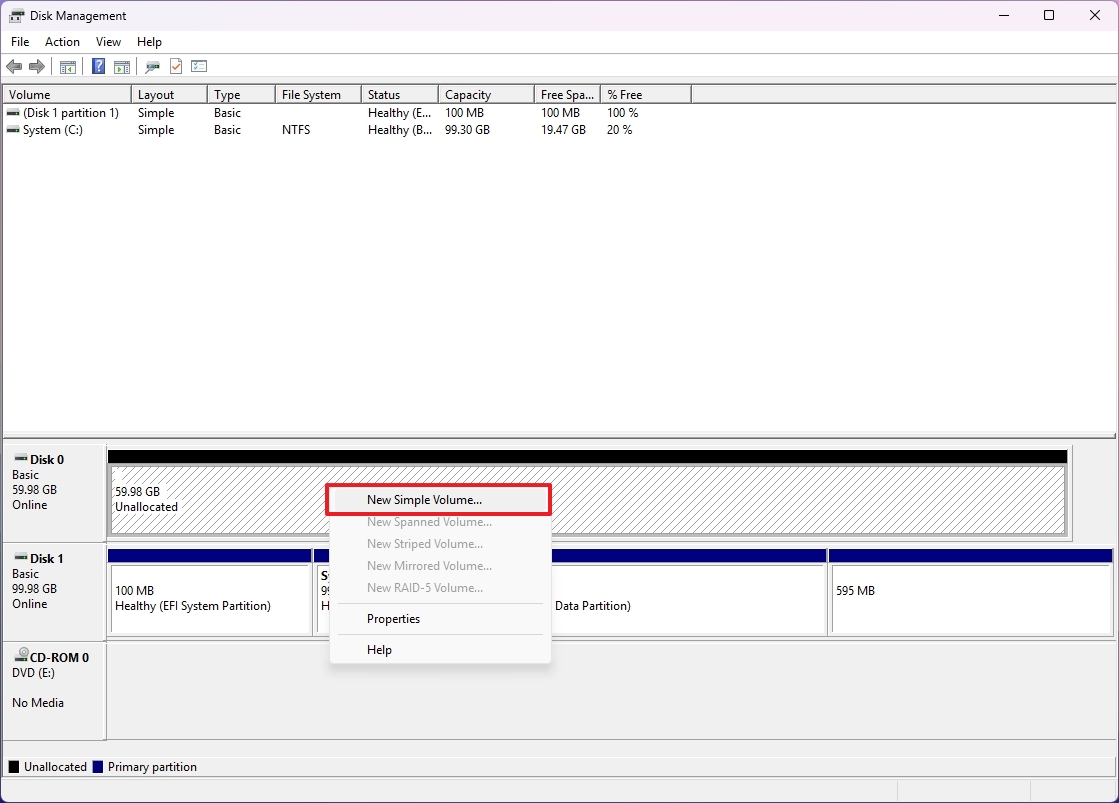
- Click the Next button.
- Click the Next button to use the space for the partition, or specify the size using the "Simple volume size in MB" option.
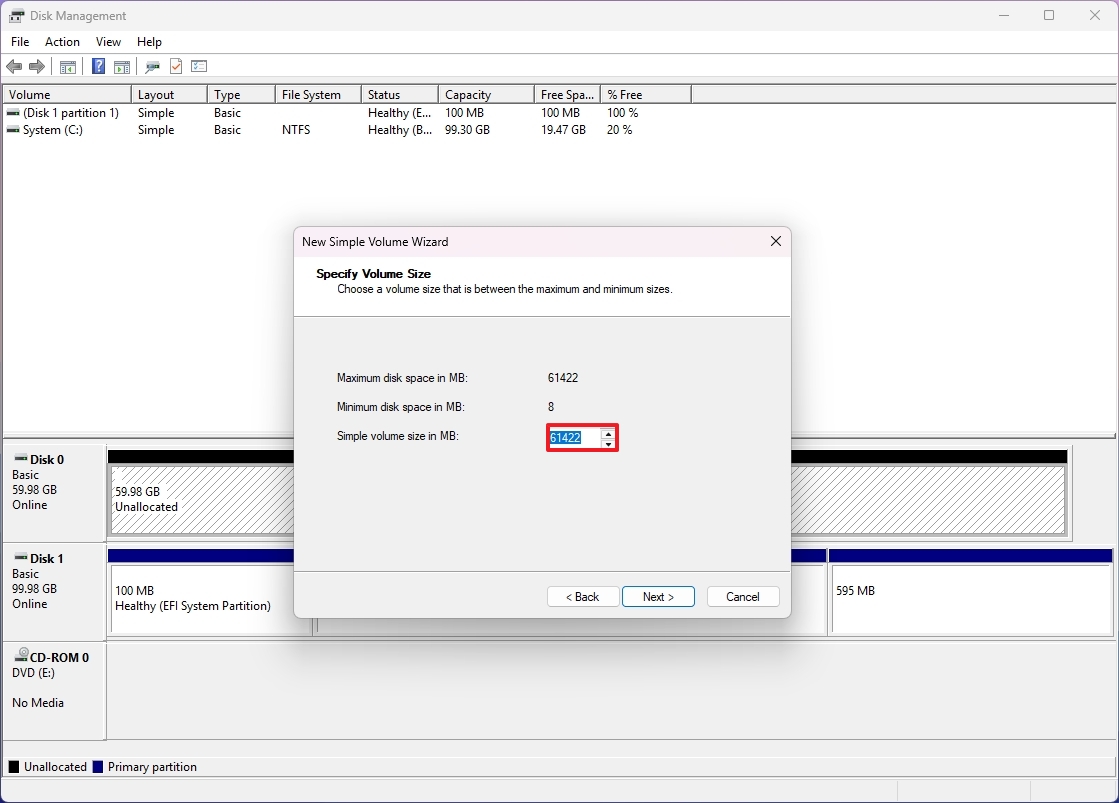
- Click the Next button.
- Select the "Assign the following driver letter" option.
- Choose the drive letter.
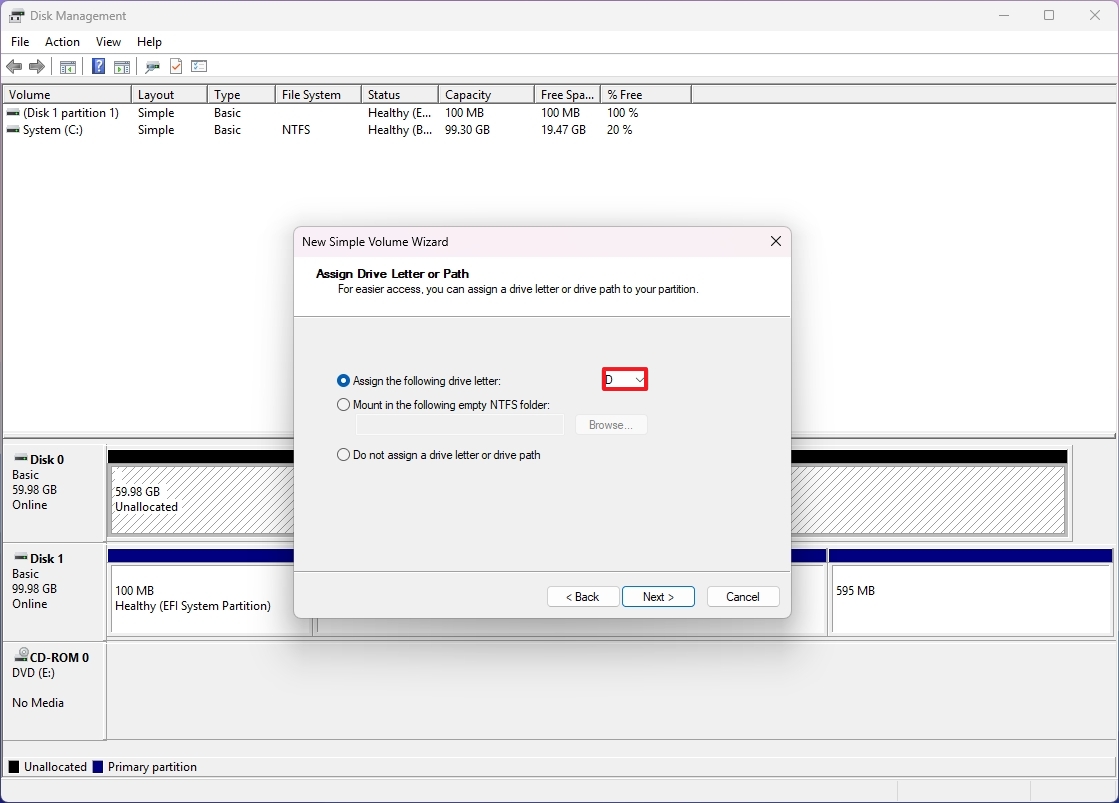
- Click the Next button.
- Select the "Format this volume with the following settings" option.
- Choose the NTFS option from the "File system" setting.
- Select the Default option from the "Allocation unit" setting.
- In the "Volume label" field, confirm a descriptive name for the drive.
- Check the "Perform a quick format" option.
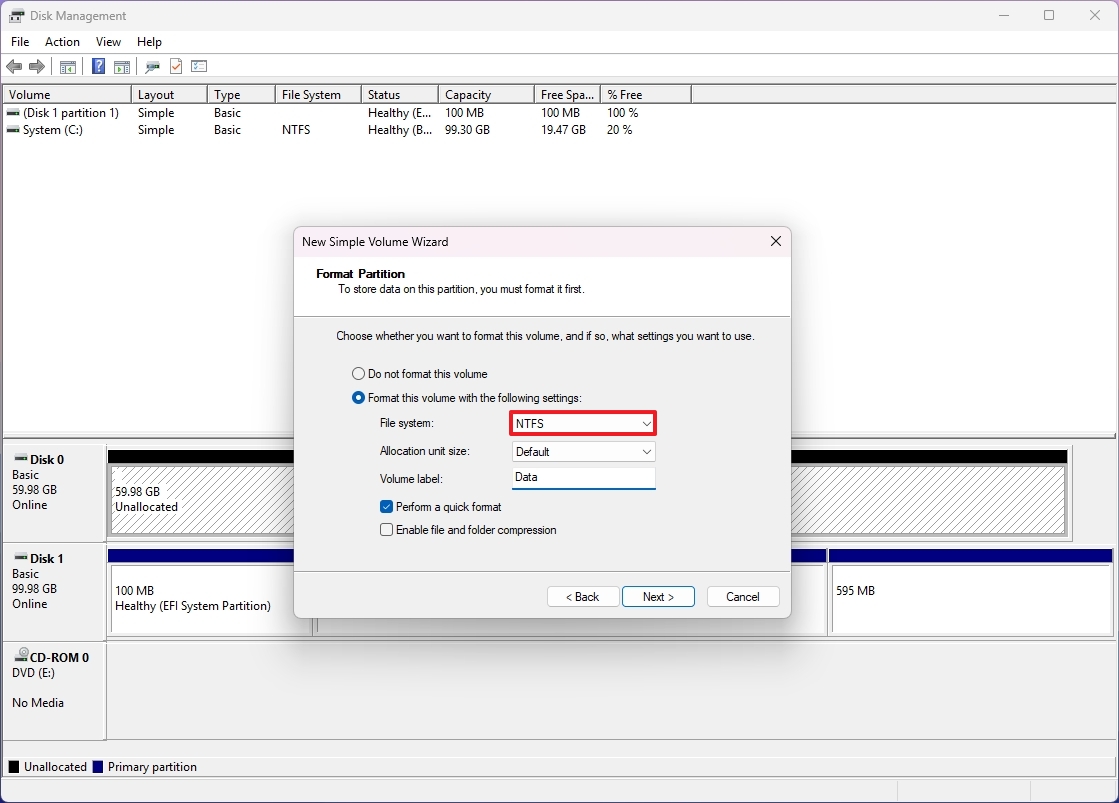
- Click the Next button.
- Click the Finish button.
Once you complete the steps, the hard drive should be accessible from File Explorer on Windows 11.
How to fix missing storage on File Explorer via Settings app
The "Disks & Volumes" settings page works similarly to the "Disk Management" app. The difference is that the modern version of the experience doesn't have every option, as the legacy version and workflow are slightly different.
Initialize new drive
To initialize a hard drive through the Settings app, use these steps:
- Open Settings.
- Click on System.
- Click the Storage page on the right side.
- Click "Advanced storage settings" under the "Storage management" section.
- Click on Disks & Volumes.
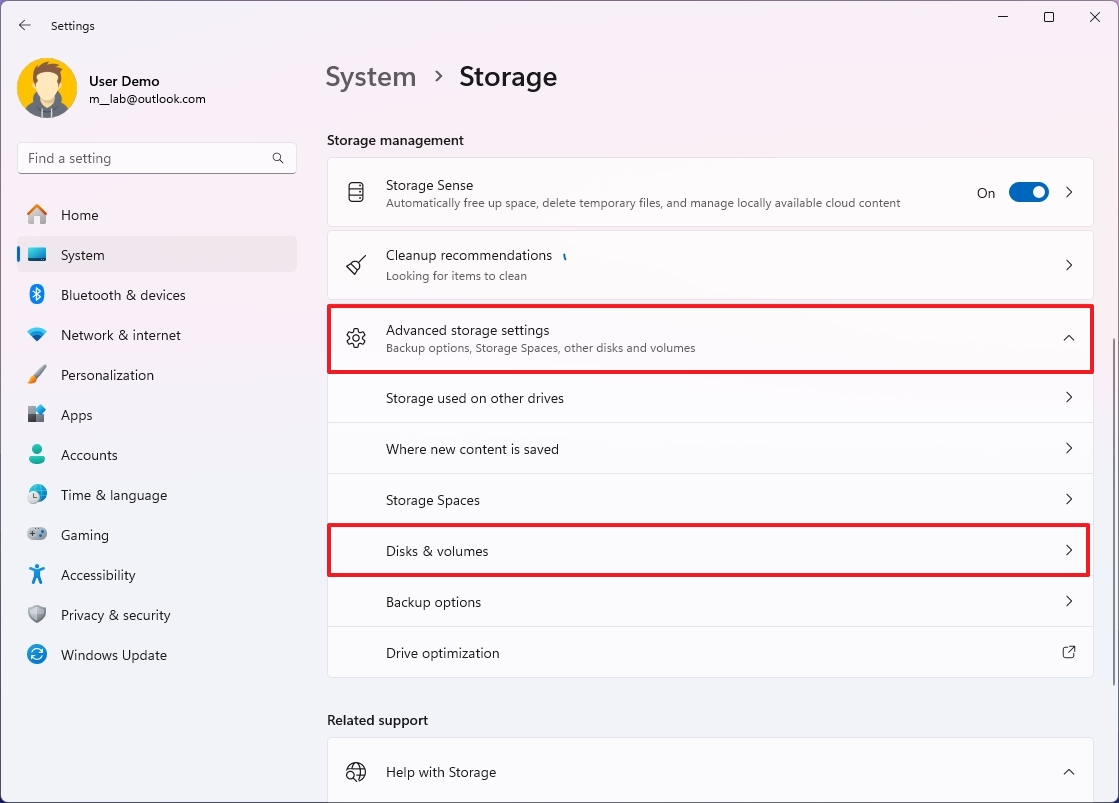
- Click the Initialize button on the drive.
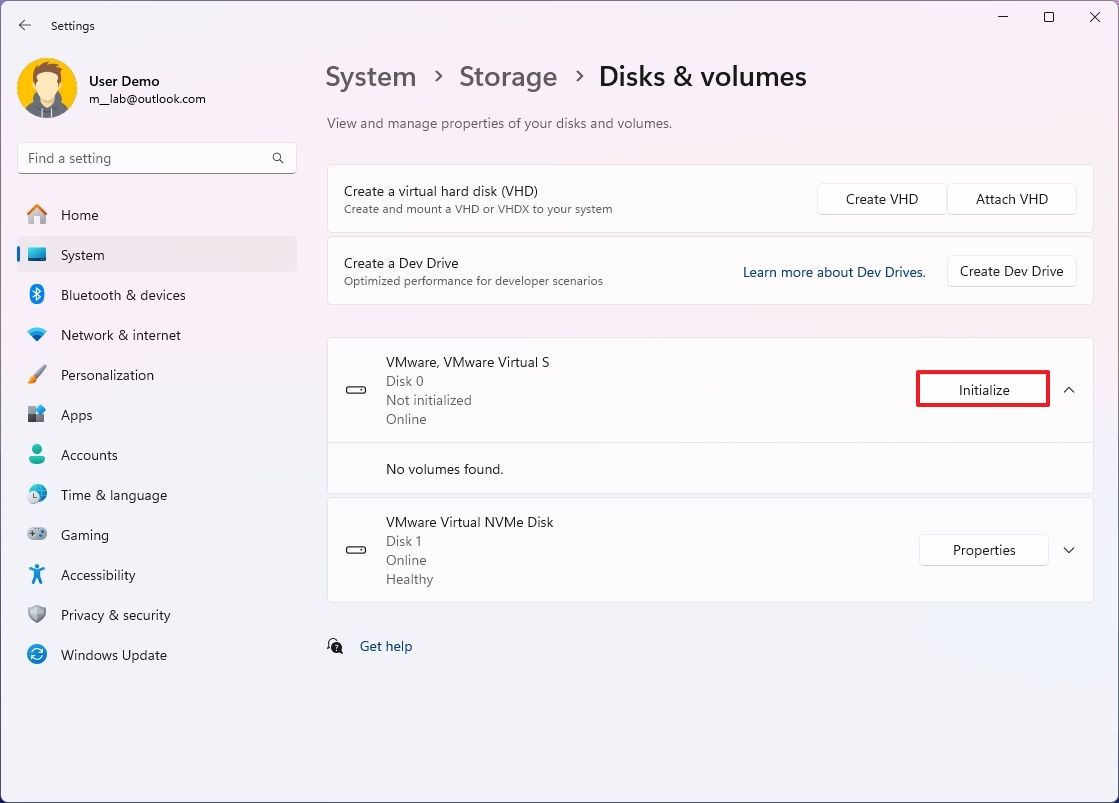
- Choose the "GPT (GUID Partition Table)" option.
- Click the Initialize button.
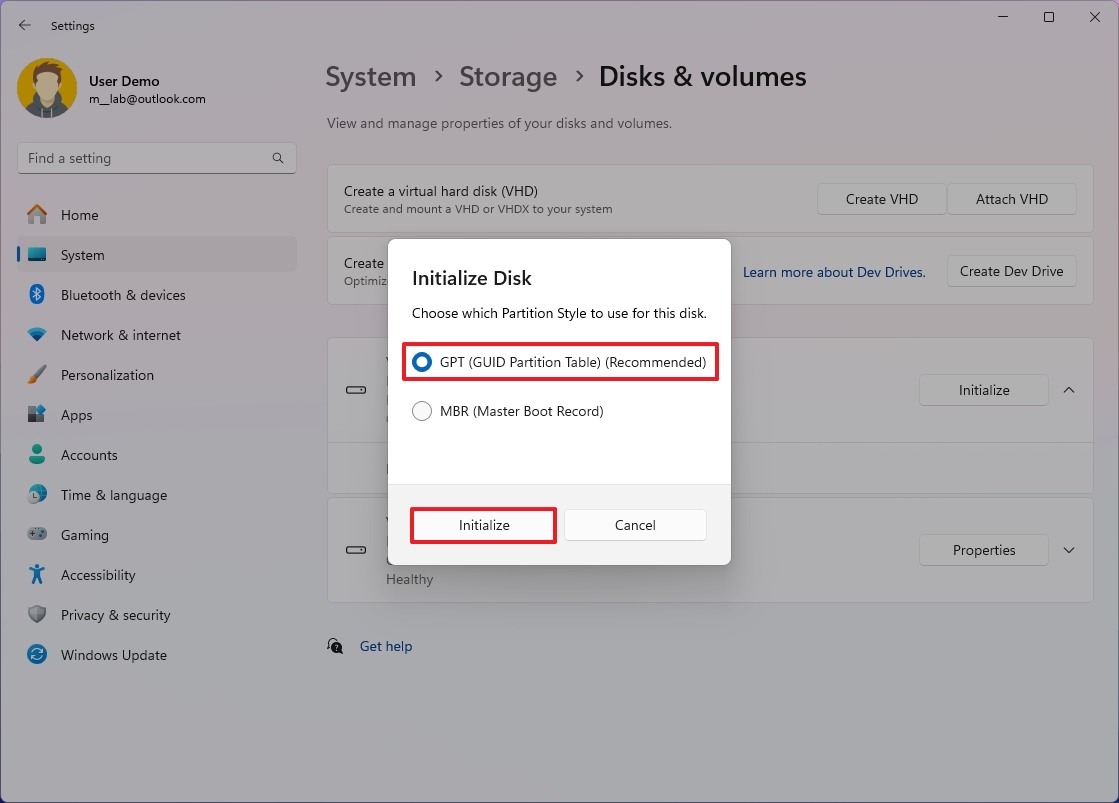
After you complete the steps, this action will delete everything from the drive and make the storage ready to store a new partition.
Create new partition
To create a new partition on the drive, use these steps:
- Open Settings.
- Click on System.
- Click the Storage page on the right side.
- Click "Advanced storage settings" under the "Storage management" section.
- Click on Disks & Volumes.

- Click on the drive to configure.
- Choose the "Create Simple Volume" option from the unallocated space.
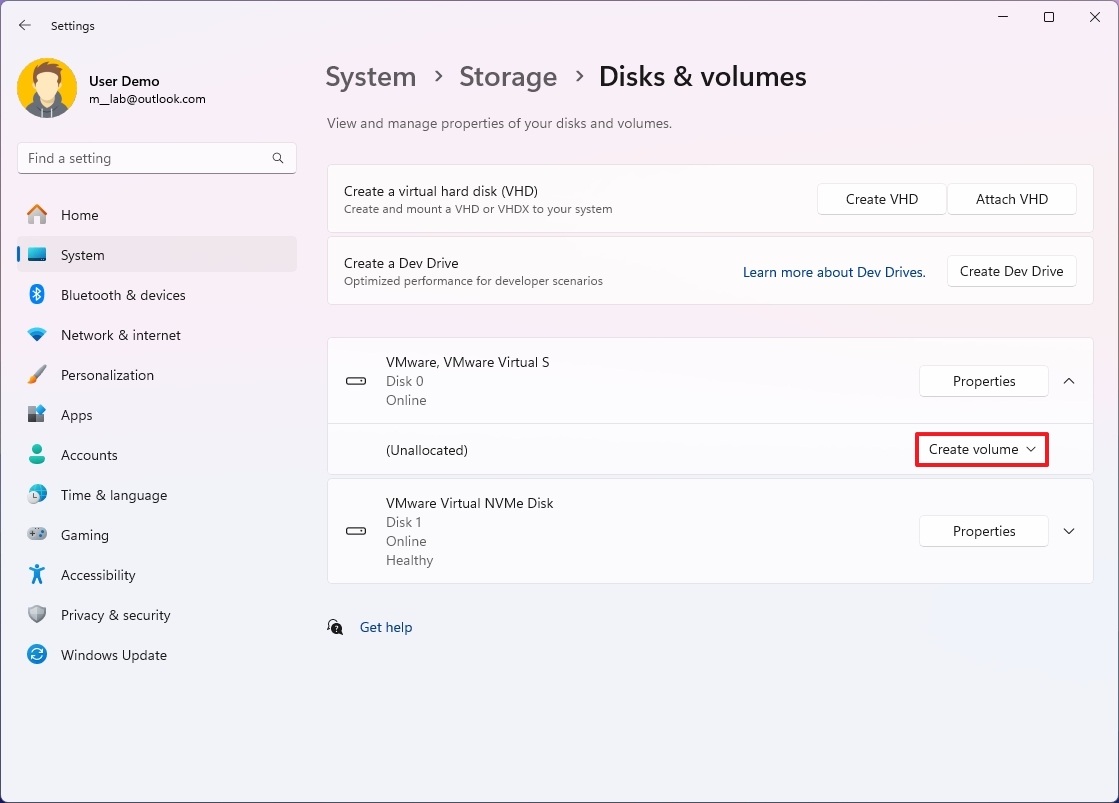
- Confirm a name for the drive in the "Label" setting.
- Choose the drive letter from the "Drive Letter" setting.
- Select the NTFS option from the "File System" setting.
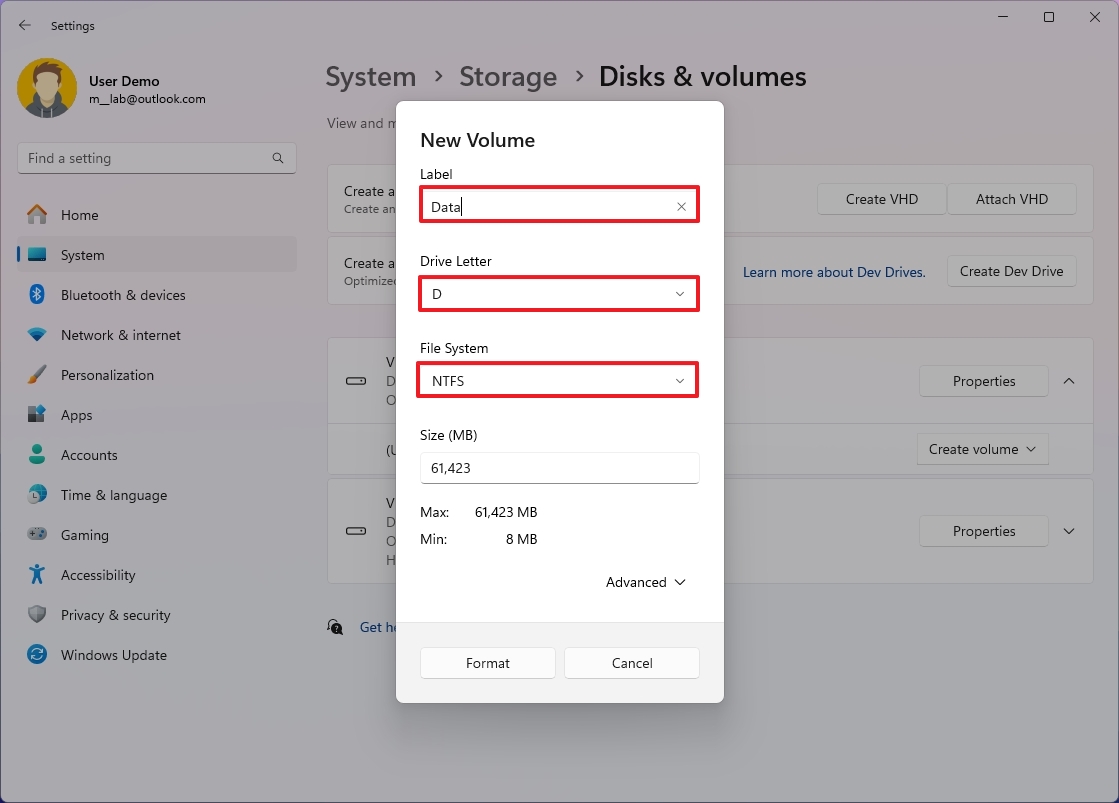
- Confirm a name for the drive in the "Label" setting.
- Choose the drive letter from the "Drive Letter" setting.
- Select the NTFS option from the "File System" setting.
- Continue with the default settings to use the entire drive to create the partition.
- Click the Format button.
Once you complete the steps, the drive should appear on File Explorer.
Change drive to online
You can only bring the drive online if the device was previously configured on the same computer.
To bring a drive online from the Settings app, use the following steps:
- Open Settings.
- Click on System.
- Click the Storage page on the right side.
- Click "Advanced storage settings" under the "Storage management" section.
- Click on Disks & Volumes.

- Click the Properties button for the drive to bring online.
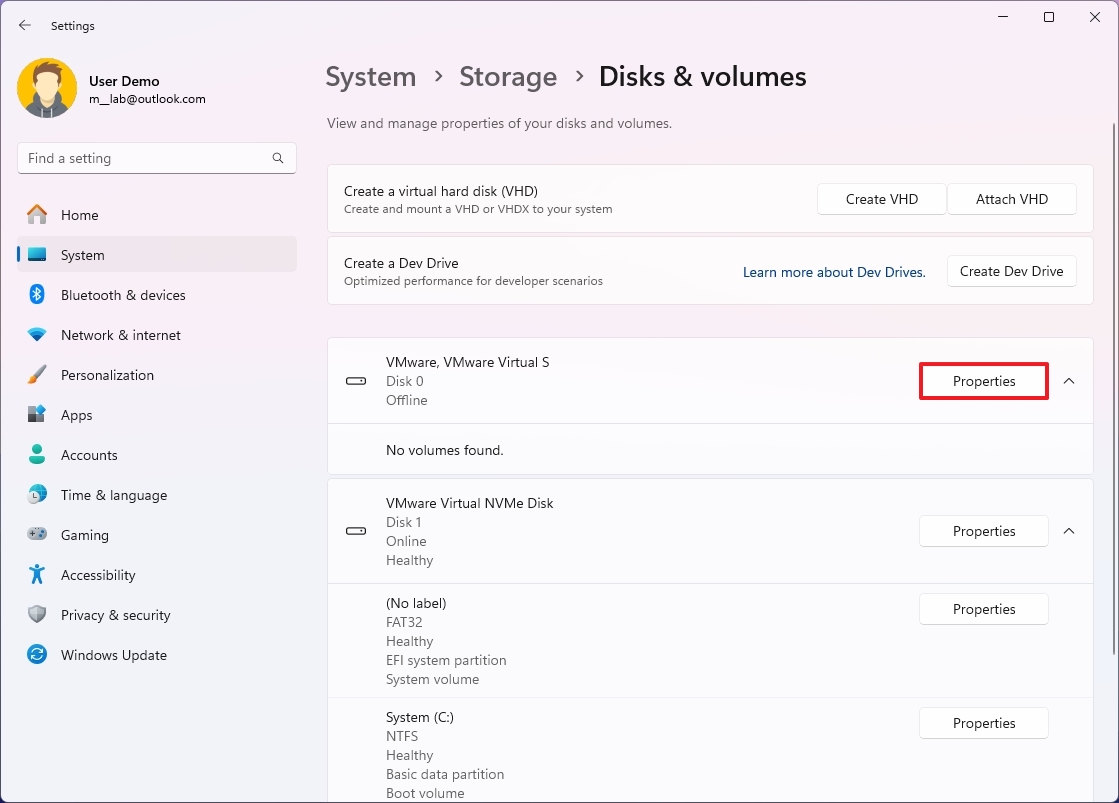
- Click the Bring online button under the "Status" section.
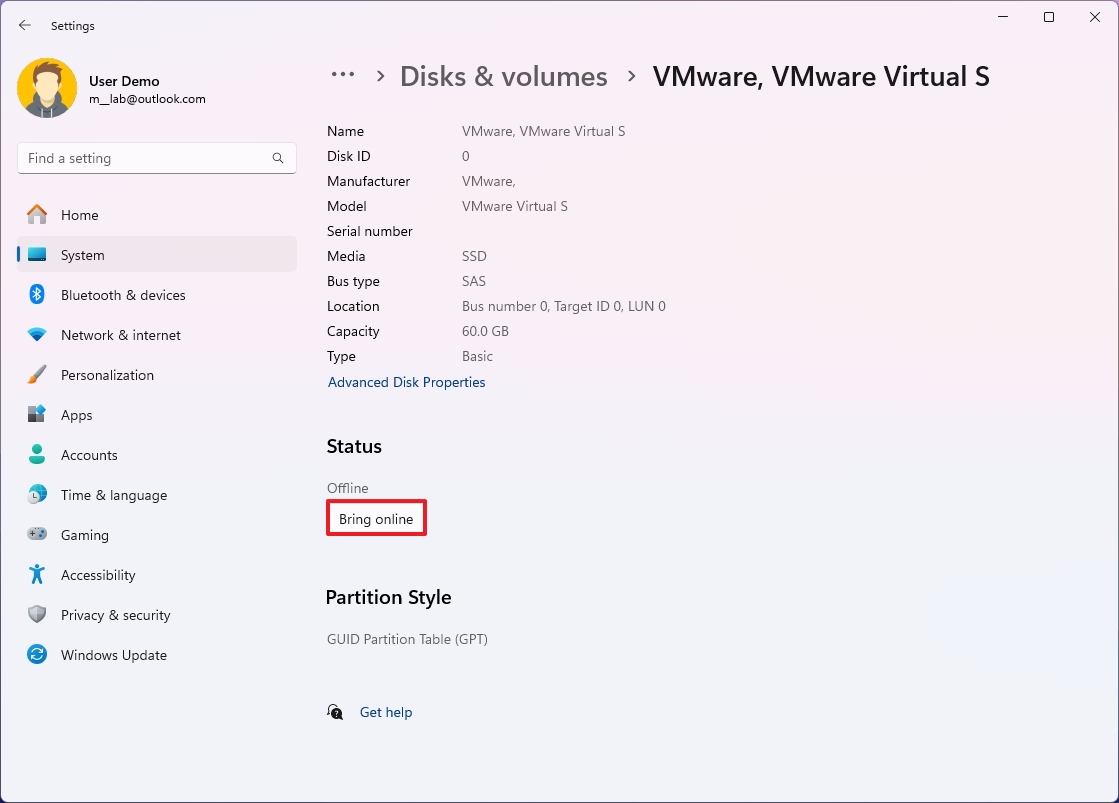
After you complete the steps, the hard drive should be accessible from the "This PC" page on File Explorer.
Configure drive letter
To assign a drive letter to a drive to make the storage available on Windows 11, use these steps:
- Open Settings.
- Click on System.
- Click the Storage page on the right side.
- Click "Advanced storage settings" under the "Storage management" section.
- Click on Disks & Volumes.

- Click on the drive to configure.
- Click the Properties button for the partition (not the drive).
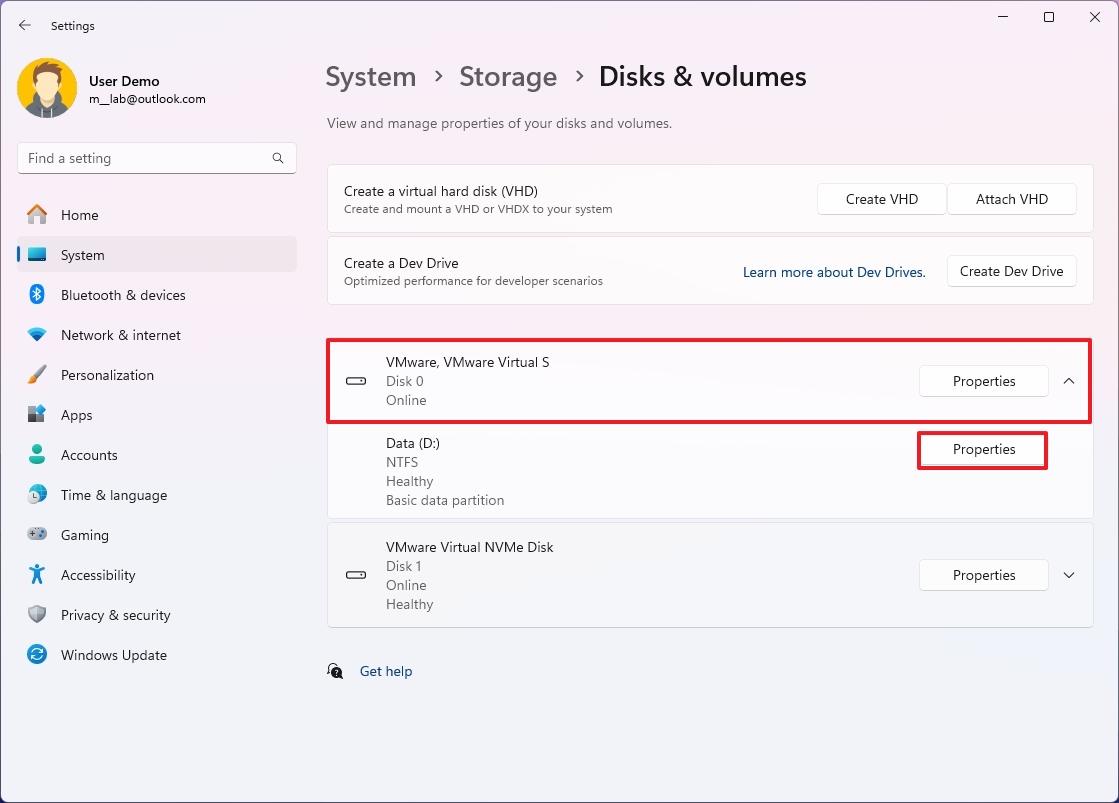
- Click the "Change drive letter" button.
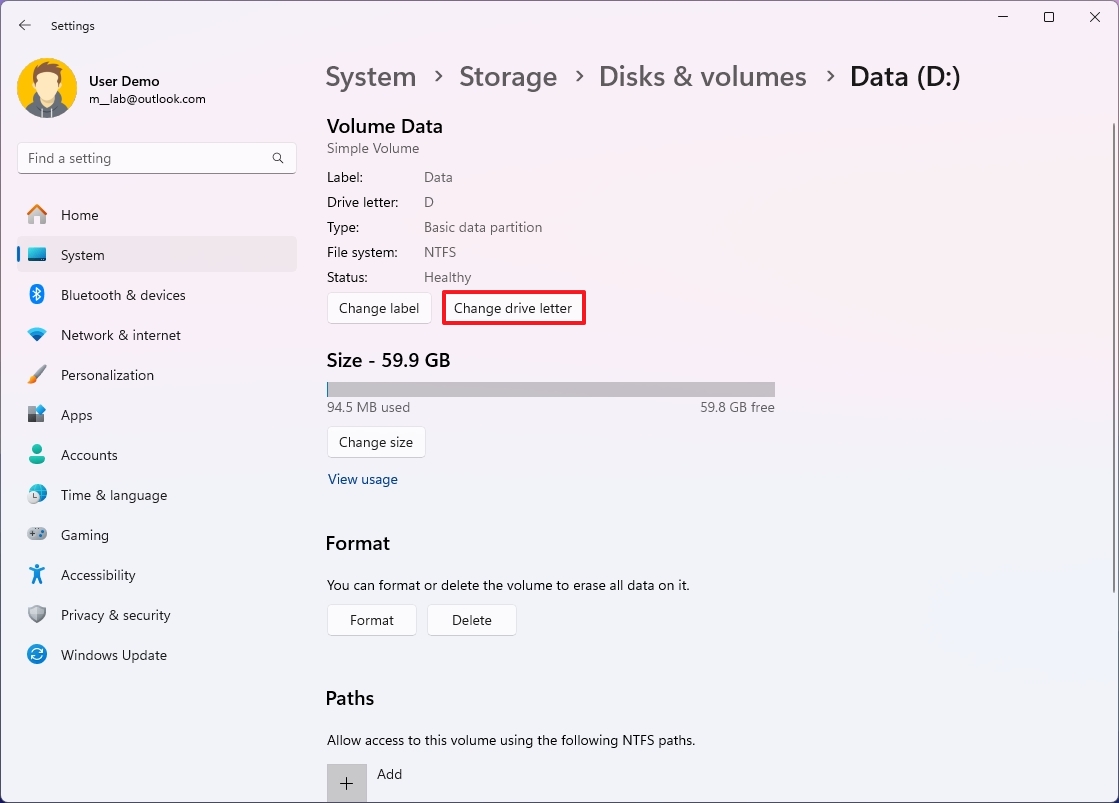
- Select the drive letter to make the storage accessible.
- Click the OK button.
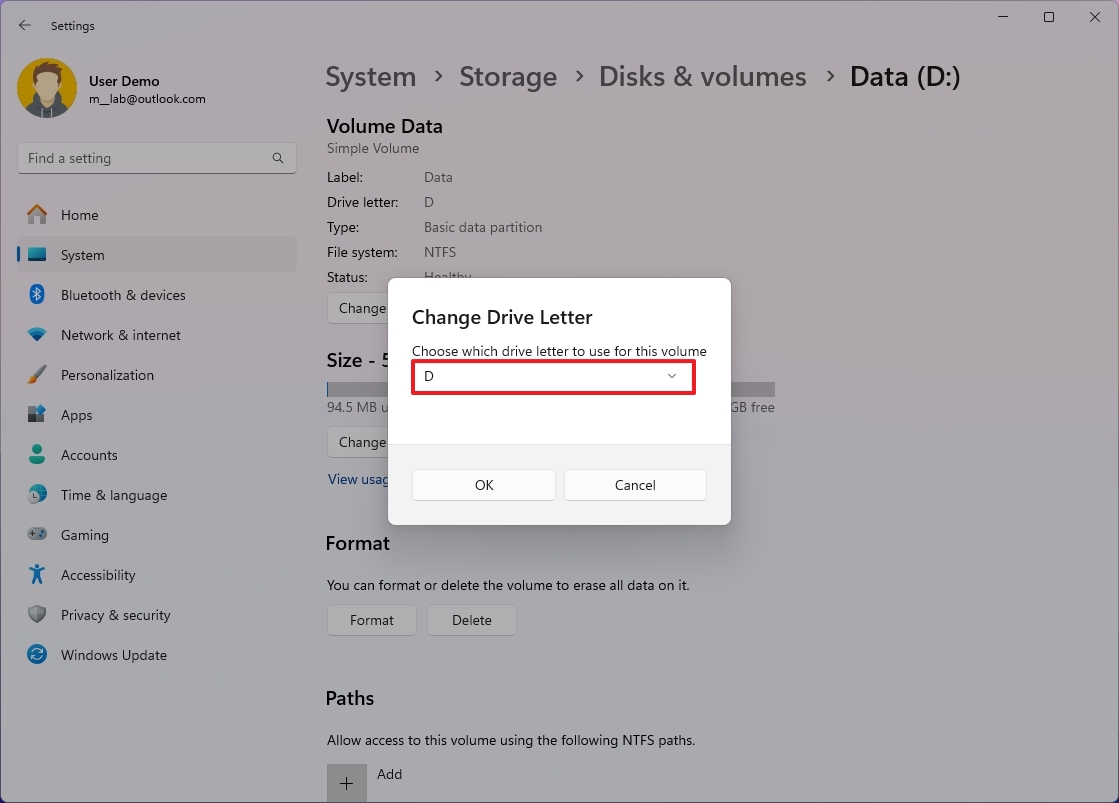
Once you complete the steps, the computer's drive data should be accessible using File Explorer.
How to fix missing storage on File Explorer via driver update
If the problem is related to a device driver, you should reinstall or update the driver to the latest version to resolve the issue.
Reinstall storage driver
To reinstall the storage driver on Windows 11, use these steps:
- Open Start.
- Search for Device Manager and click the top result to open the app.
- Expand the Disk drives branch.
- Right-click the hard drive in question and select the Uninstall device option.
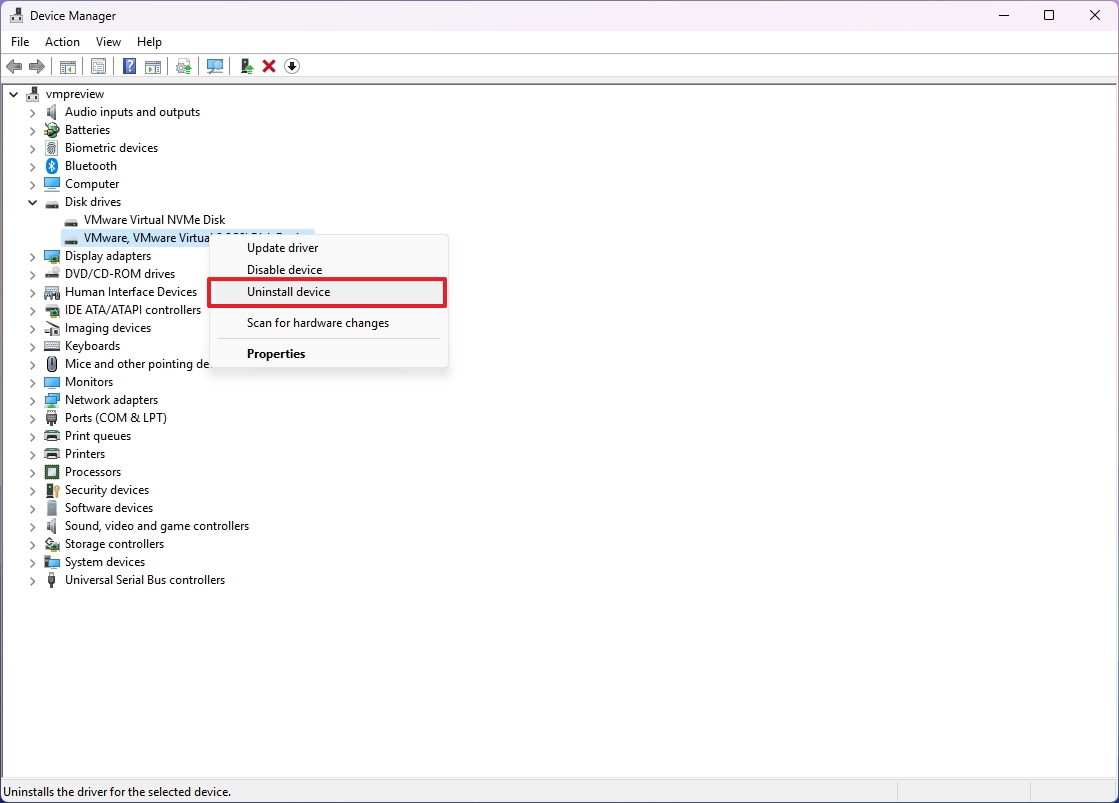
- Click the Uninstall button.
- Restart the computer
Once you complete the steps, the system should reinstall the driver automatically, and you should now be able to access the data on the drive from File Explorer.
Update storage driver
To update the storage driver, use these steps:
- Open Settings.
- Click on Windows Update.
- Click the Advanced options page on the right side.
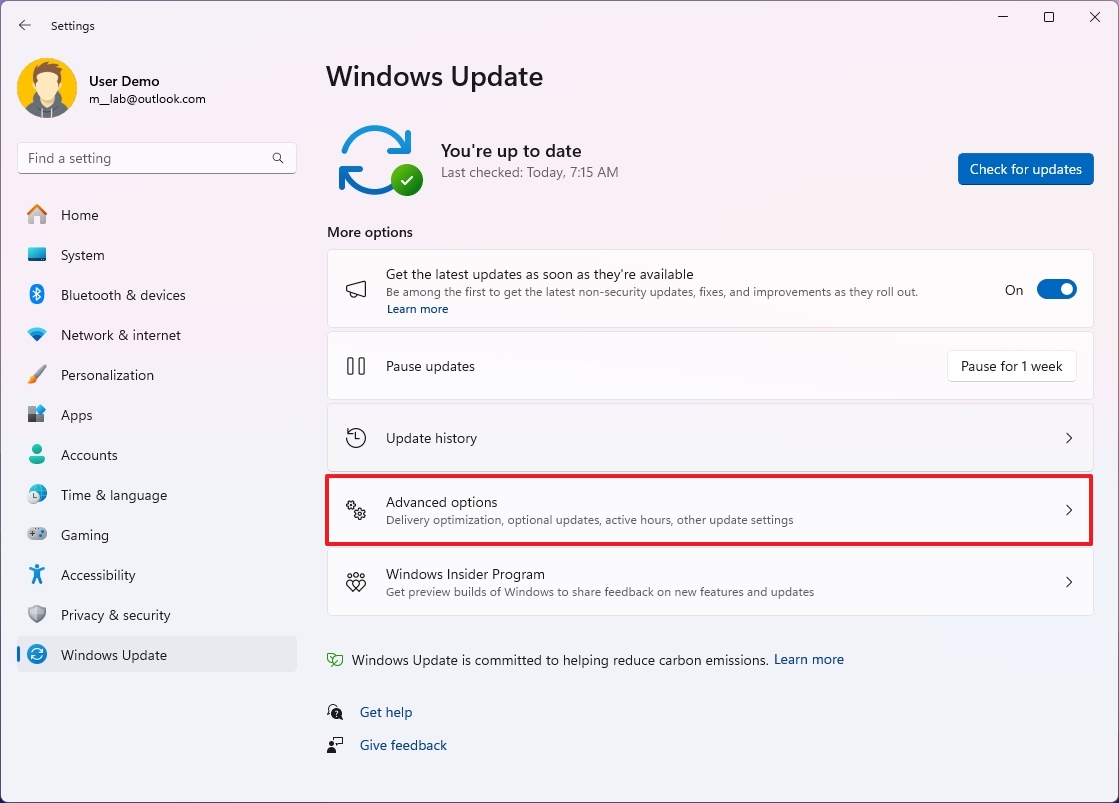
- Click the Optional updates settings from the "Additional options" section.
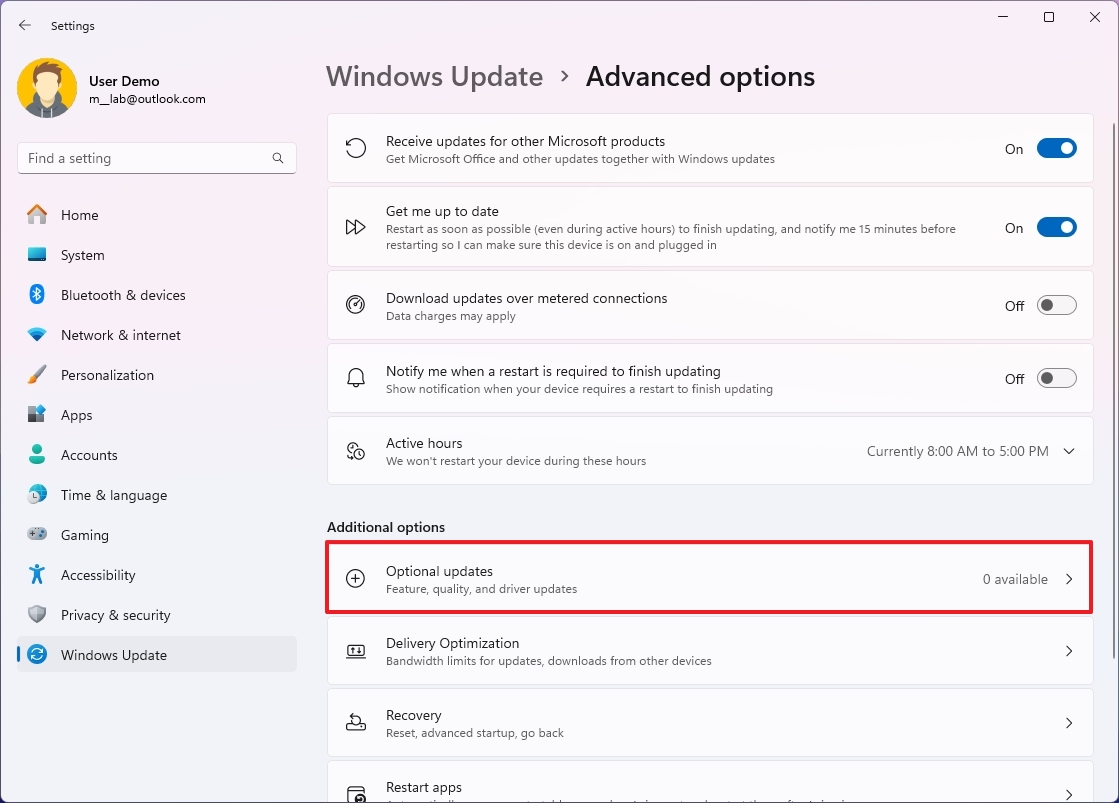
- Choose the driver update (if applicable).
- Click the Download & install button.
After you complete the steps, the driver will download and install it on the computer to make the storage accessible.
It's important to note that it could also be a problem with storage firmware. If so, you must check your manufacturer support website to download their tool to update the hard drive. (This is only recommended if a known issue and a new firmware update becomes available to resolve the problem.)
How to fix missing storage on File Explorer via Command Prompt
If, after trying the above recommendations, it's still not possible to access the storage, you can use the DiskPart command tool to completely clean the drive.
To use DiskPart with Command Prompt to clean a drive, use these steps:
- Open Start.
- Search for Command Prompt, right-click the top result, and select the Run as administrator option.
- Type the following command to start diskpart and press Enter: diskpart
- Type the following command to list the available disks and press Enter: list disk
- Type the following command to select the drive not showing up in File Explorer and press Enter: select disk 1
- In the command, select the correct drive. Otherwise, you may end up deleting the data in the wrong partition.
- Type the following command to everything erase the drive and press Enter: clean
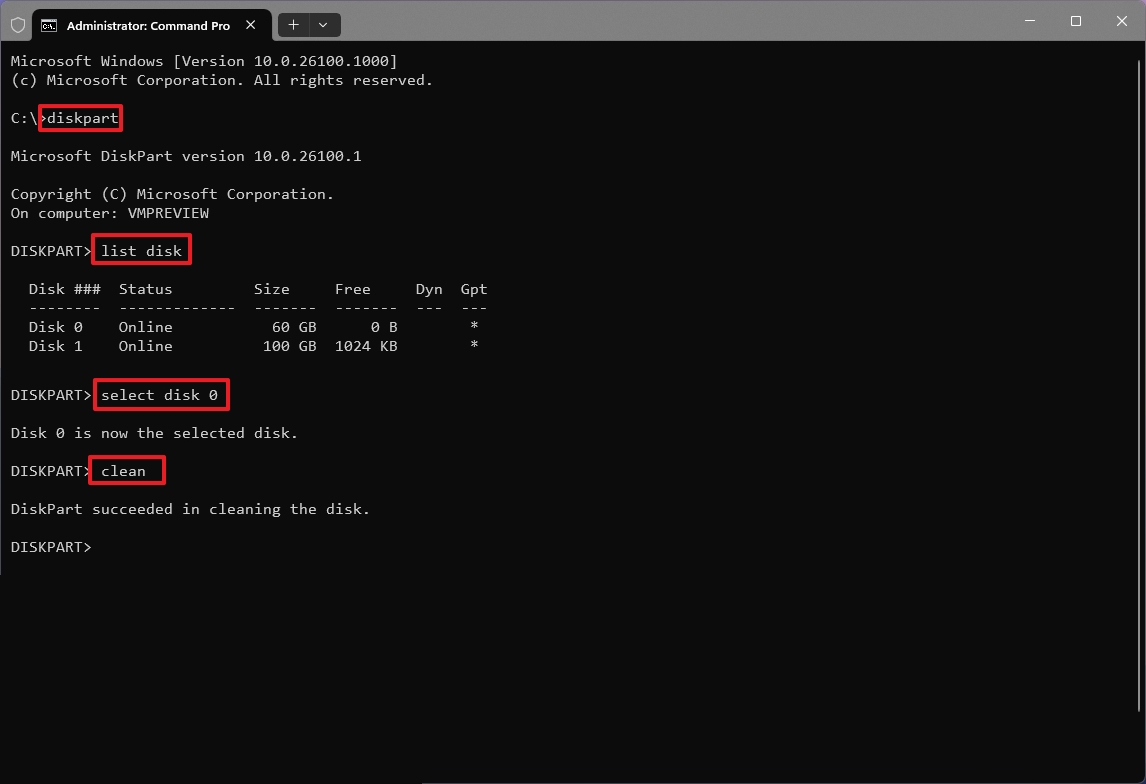
- Warning: The command will delete everything, including data, partition, type, and the drive will appear blank with the label unknown and not initialized.
- Type the following command to create a partition using the available space and press Enter: create partition primary
- Type the following command to select the newly created partition and press Enter: select partition 1
- Type the following command to set the partition as active and press Enter: active
- Type the following command to format the partition and press Enter: format FS=NTFS
- Type the following command to assign a drive letter and press Enter: assign letter=D
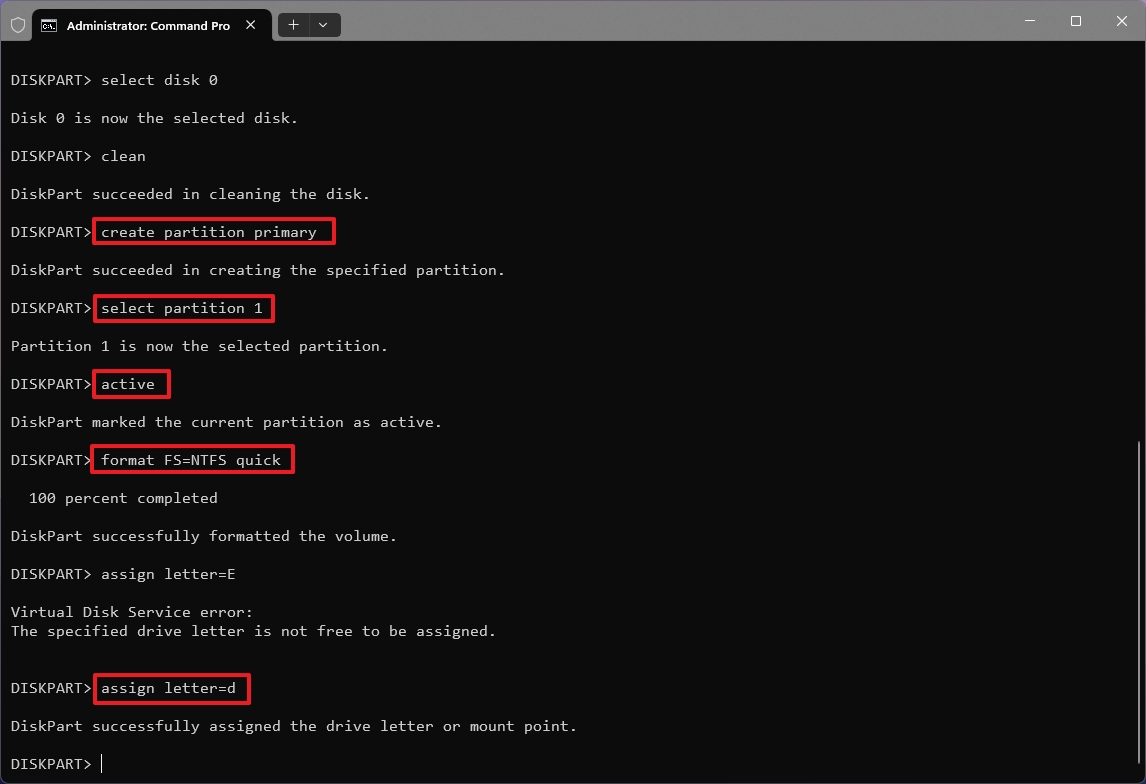
In the command, change "D" for another drive letter not already in use.
- Type the following command to close diskpart and press Enter: exit
Once you complete the steps, the drive will be formatted with the specified settings, and it should now appear in File Explorer and across applications.
More resources
For more helpful articles, coverage, and answers to common questions about Windows 10 and Windows 11, visit the following resources:







